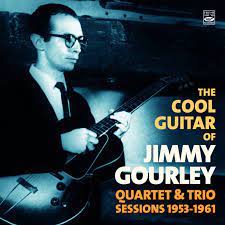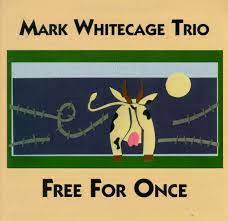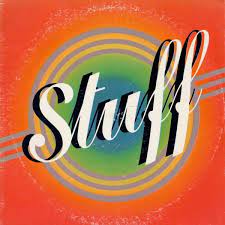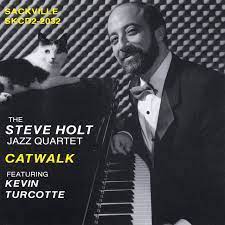
Daily Dose Of Jazz…
James Pasco Gourley, Jr. was born June 9, 1926 in St. Louis, Missouri. He met saxophonist Lee Konitz in Chicago when both were members of the same high school band and credits Konitz with encouraging him to become a serious musician.
His father started the Monarch Conservatory of Music in Hammond, Indiana, though he didn’t teach and bought his son his first guitar. Jimmy took his first guitar classes at the school and became interested in jazz while listening to the radio, enjoying in particular Nat King Cole. For his first professional experience as a performer, he dropped out of high school to play with a jazz band in Oklahoma City, Oklahoma.
From 1944 to 1946 Gourley served in the U.S. Navy. Upon his return to Chicago, Illinois he met guitarist Jimmy Raney and wanted to play like him. He worked in bars and clubs with Jackie Cain & Roy Kral, Anita O’Day, Sonny Stitt, and Gene Ammons. Through the G.I. Bill he received tuition for three years to any college in the world.
Beginning in 1951, Jimmy spent the rest of his life in France, working with Henri Renaud, Lou Bennett, Kenny Clarke, Richard Galliano, Stéphane Grappelli, Bobby Jaspar, Eddy Louiss, Martial Solal, and Barney Wilen. He played with American musicians who were passing through, including Bob Brookmeyer, Clifford Brown, Stan Getz, Gigi Gryce, Roy Haynes, Lee Konitz, Bud Powell, Zoot Sims, Lucky Thompson, and Lester Young.
Guitarist Jimmy Gourley, who spent the better part of his life in Paris, France transitioned at the age of 82 on December 7, 2008 in Villeneuve-Saint-Georges, France.
More Posts: bandleader,guitar,history,instrumental,jazz,music

Daily Dose Of Jazz…
Mark Whitecage was born on June 4, 1937 in Litchfield, Connecticut and began playing in his father’s family ensemble as early as age six. In his youth he listened a lot to Roy Eldridge, Ben Webster, Lester Young and Stan Getz. He moved to New York City in the 1970s and was loosely associated with the loft scene with INTERface, a quartet with clarinetist Perry Robinson, bassist John Shea and pianist John Fischer. Fortune smiled and he met Gunter Hampel and ong tours with Hampel’s Galaxie Dream Band became a way of life, which helped him to build up a network outside the US.
In the 1980s, he played with Gunter Hampel’s Galaxy Dream Band, Jeanne Lee, and Saheb Sarbib. After touring solo in Europe in 1986, he put together two bands as a leader, Liquid Time and the Glass House Ensemble. By the Nineties he was releasing his first album with Liquid Time which was chosen by Cadence Magazine as one of the year’s best albums.
He worked in the Improvisers Collective from 1994, and began releasing albums on CIMP in 1996. Late in the decade he worked with Anthony Braxton, including in performances of Braxton’s opera, Trillium R. He also played with William Parker, Perry Robinson, Joe Fonda, Dominic Duval, Joe McPhee, Steve Swell, Richie “Shakin'” Nagan and Sikiru Adepoju.
His marriage to clarinetist Rozanne Levine led to him performing together with Perry Robinson in a trio called Crystal Clarinets. Alto saxophonist and clarinetist Mark Whitecage, who recorded fifteen albums as a leader and another 60 as a sideman, transitioned on March 7, 2021.
More Posts: clarinet,history,instrumental,jazz,music,saxophone

Daily Dose Of Jazz…
Herbie Lovelle was born June 1, 1924 in Brooklyn, New York. His uncle was drummer Arthur Herbert. He began his career in the late 1940s with the trumpeter, singer and bandleader Hot Lips Page. By the 1950s he was playing with the saxophonist Hal Singer, Johnny Moore’s Three Blazers and the pianist Earl Hines.
Through working for both Lucky Thompson and Jimmy Rushing of Count Basie’s Orchestra, he became house drummer at the Savoy Ballroom in New York City for much of the 1950s. He toured with the tenor saxophonist Arnett Cobb and the pianist Teddy Wilson in 1954.
He contributed to the pianist Paul Curry’s album Paul Curry Presents the Friends of Fats in 1959. Then in the early years of television, Herbie performed with the King Guion Orchestra on the Jerry Lester Show and the Ed Sullivan Show. In 1966, he was the lead drummer for the Sammy Davis, Jr. TV show.
During the 1950s Lovelle began playing more R&B and worked as a studio musician recording behind Sam Taylor, Bob Dylan, Pearls Before Swine, Eric Andersen, David Blue, John Denver, Tom Rush, B. B. King, John Martyn, the Strangeloves, the McCoys, and the Monkees. He continued working as a studio musician well into the 1980s.
In 1976, he produced the first album by Stuff, which went platinum in Japan. He also played drums in the 1976 revival of Guys and Dolls. From the 1980s on he acted in film and television, on such shows as Law & Order and Third Watch. His film credits ~ A Man Called Adam, Bella, Mitchellville, The Rhythm of the Saints, Don’t Explain, The Curse of the Jade Scorpion, and Down to Earth among others.
His list of recordings as a studio musician extended across genres to some six dozen albums with jazz notables Candido Camero, Buck Clayton , Art Farmer, Herbie Mann, Sonny Stitt, Budd Johnson, Buddy Tate, Chico O’Farrill, Evie Sands, Johnny Hodges, Nat Adderley, Tony Bennett, Illinois Jacquet and numerous others. Drummer, producer and actor Herbie Lovelle transitioned on April 8, 2009 in New York City.

Daily Dose Of Jazz…
Steve Holt was born in Montreal, Quebec, Canada on May 9, 1954 and exhibited musical ability in early childhood, playing piano at the age of four. By the time he was a teenager, he was a regular on the Montreal club scene.
Self-taught until he entered McGill University, he received instruction from pianist Armas Maiste, whose bebop playing influenced him. Holt became a student of Kenny Barron, traveling regularly to New York City for private lessons. Graduating from McGill in 1981 with that university’s first Bachelor of Music major in Jazz Performance, he taught jazz improvisation there.
Steve’s 1983 debut album, The Lion’s Eyes was nominated for a Juno Award. He has worked with Larry Coryell, Eddie Henderson, and Archie Shepp. Moving to Toronto, Canada in 1987 he worked as an equity analyst and for a time he also continued playing clubs at night. He released three albums in the early Nineties ~ Christmas Light, Just Duet and Catwalk.
At the end of the decade Holt returned his concentration to music full-time and three years later his fifth album, The Dream, was released. He turned his attention to music production and stopped performing jazz live until 2014. A move to the countryside reignited his interest in jazz performance and in 2017 he opened a health food store in Warkworth, Ontario that operates as a jazz venue once a week.
Pianist Steve Hunt continues to play jazz while maintaining outside interests.
More Posts: bandleader,history,instrumental,jazz,music,piano

Daily Dose Of Jazz…
Denys Justin Wright was born on May 6, 1924 in Deptford, London, England and grew up in Brockley. His first instrument was the piano but was soon trying to play his brother’s guitar. Known professionally as Denny Wright, he began playing professionally before World War II while at school. He nearly always used his thumb on the top E string and could only play as fast as he could sing.
Wright spent the first part of World War II playing in jazz clubs in the West End of London, doing session work and performing in bands on radio shows. He worked with Stephane Grappelli for the first time in London around 1941. At school he served with the Auxiliary Fire Service in Brockley. Classified medically unfit to serve due to a childhood injury, he joined Entertainments National Service Association (ENSA), entertaining the troops.
In 1945 he started the first bebop club in London where he played piano and guitar. The late 1940s saw him touring Italy and the Middle East with the Francisco Cavez Orchestra. Throughout the 1950s DEnny provided guitar accompaniments for Lonnie Donegan, Johnny Duncan, Humphrey Lyttelton, and Marie Bryant, as well as appearing on Guitar Club on the BBC. In 1952, he accompanied Tex Ritter for a season at the Texas Western Spectacle, and with Joel David on Old Bones and added a guitar solo on Be My Valentine Tonight.
Establishing the Denny Wright Trio with violinist Bob Clarke took skiffle and jazz to the Soviet Union in 1957 for the 6th World Festival of Youth and Students. For four decades from the Forties he worked as a session musician working with the likes of Mary Hopkin, Dusty Springfield and Tom Jones. In the 1960s, he went on to record under The Cooper-Wright Quintet, and during the late Seventies formed the band Velvet with Ike Isaacs, Len Skeat, and Digby Fairweather.
Never one to not be working he continued to put bands together as well as lecturing and giving private lessons. He arranged for and fixed sessions, and was a prolific jazz and orchestra composer. He worked with Latin American, Afro-Cuban and Jamaican bands. Denny was voted the 1980 BBC Jazz Society Musician of the Year.
Guitarist, pianist, arranger and composer Denny Wright transitioned on February 8, 1992 in London after a nine-year battle with bladder cancer.
More Posts: bandleader,guitar,history,instrumental,jazz,music



